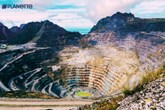Mine smarter, waste less
Published by Will Owen,
Editor
Global Mining Review,
Alaina Harkness (Great Lakes ReNEW) and Batchimeg Ganbaatar (Nomadic Venture Partners) outline how the road to real critical mineral independence will be paved by greater innovation in water management.
Two truths are on a collision course. The US is trying to fast-track permits for about 20 new domestic mines to secure a reliable supply of critical minerals, but the mining industry perennially underinvests in innovation – the five largest mining companies spent just 0.4% of revenue on research and development on average in 2018. Both of these cannot continue to be true if the US is serious about achieving critical mineral independence.
More innovations that help the mining industry reduce waste and mitigate harm to surrounding communities are in especially high demand. Without innovation, the industry will continue to flush valuable resources downstream, while also risking harm to public health and the environment.
Water first
The most urgent area for innovation is water. Mining uses enormous volumes of it for ore processing, dust suppression, and waste management – often in arid, water-scarce regions. But mining does not just consume water; it also risks contaminating it through acid mine drainage and heavy metal pollution in nearby groundwater and surface water. Innovation here must take several forms: improving dry or near-dry ore processing, enhancing on-site water recycling systems and adopting real-time water quality monitoring. These technologies already exist but face barriers to commercialisation and scale; they also need stronger regulation or incentives to force or make it less burdensome for companies to adopt them.
Reducing waste
Next must come innovations that reduce the sheer volume of waste mining generates – a volume that is only growing. The easy stuff has already been mined, getting out anything that remains requires greater effort to go deeper and unearth much more.
Additionally, for every tonne of rare earth extracted, miners can leave behind hundreds of tonnes of tailings – the often-toxic slurry of leftover material. This creates a need for precision mining that minimises overburden removal, low-impact mining methods, and smarter ore-sorting technologies.
Mining the mining waste
Third, waste needs to be reconsidered altogether – framed as an opportunity rather than a burden. Many mines contain valuable minerals left behind by older, less efficient extraction methods. That is where startups, like Endolith Mining and Maverick Metals, come in.
Endolith’s uses microbes and AI to recover critical minerals from low-grade ore, turning mining waste into a low-impact resource. Meanwhile, Maverick Metals has figured out a way to turn low-grade ore and smelter slag into high-value feedstock. Both companies have figured out how to turn waste into wealth.
Overcoming objections
There is dissonance between the growing demand for critical minerals and the American public’s discomfort with mining. The public wants the benefits – including clean tech and renewable energy – without the extraction happening anywhere near them. But with reliance on critical minerals only increasing, it is time to foster the innovation necessary to make cleaner, more responsible, and ethical mining possible.
Opposition has already stalled or killed two copper-nickel mines in Minnesota, a copper mine in Arizona, uranium mines in New Mexico, and a copper mine in Michigan’s Upper Peninsula, just to name a few. Groundwater contamination almost always tops the community’s list of concerns. To overcome concerns such as this, greater collaboration between industry and government will be required.
The US has only recently re-engaged in a national mining strategy, while China has spent 30 years building dominance. Today, China controls more than 85% of rare earth element processing. To counter this, the US has launched the Mineral Security Partnership, an international initiative supporting private investment into dozens of critical mineral projects across Africa, Latin America, and Canada.
Next steps
On a smaller but no less important scale, Current and Nomadic Venture Partners have launched a federally funded accelerator to support startups developing clean mining technologies. Through introductions to mining companies willing to pilot new products, solutions will be developed that reduce waste, use less water, and protect both communities and the environment.
Mining’s poor reputation is well-earned and in need of reinvention, but with the right innovations, a new story can be written: one where critical minerals are mined faster, smarter, cleaner and with the community in mind. That’s the only path to real critical mineral independence.
Alaina Harkness is the CEO of Current and CEO and principal investigator of Great Lakes ReNEW, the National Science Foundation-supported Great Lakes Water Innovation Engine.
Batchimeg Ganbaatar is the co-founder and managing partner of Nomadic Venture Partners.
Read the article online at: https://www.globalminingreview.com/environment-sustainability/19062025/mine-smarter-waste-less/
You might also like
The dual threat facing modern mining
Extreme weather is reshaping mining – driving floods, drought, and costly disruptions. Long-range environmental forecasting offers a path to safer operations, stronger infrastructure, and planning amid a rapidly intensifying water cycle.


